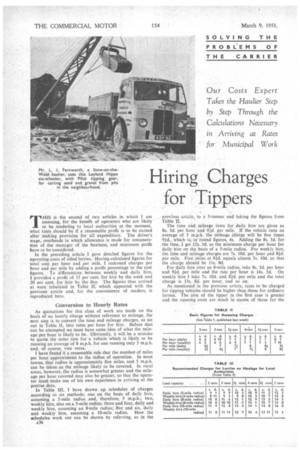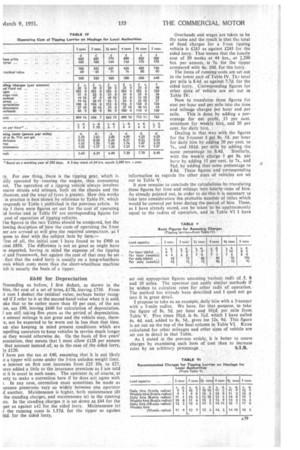Hiring Charges for Tippers
Page 54

Page 57

If you've noticed an error in this article please click here to report it so we can fix it.
Our Costs Expert Takes the Haulier Step by Step Through the Calculations Necessary in Arriving at Rates for Municipal Work THIS is the second of two articles in which I am assessing, for the benefit of operators who are likely to be tendering to local authorities at the moment, what rates should be if. a reasonable profit is to be earned after making provision for all expenditure. The driver's wage, overheads in which allowance is made for remuneration of the manager of the business, and minimum profit have to be considered.
In the preceding article I gave detailed figures for the operating costs of sided lorries. Having calculated figures for total cost per hour and per mile, I reckoned charges per hour and per mile by adding a profit percentage to the cost figures. To differentiate between weekly and daily hire, 1 provided a profit of 15 per cent. for hire by the week and 20 per cent, for hire by the day. The figures thus arrived at were tabulated in Table H, which appeared with the previous article and, for the convenience of readers, is reproduced here.
Conversion to Hourly Rates
As quotations for this class of work are made on the basis of an hourly charge without reference to mileage, the next step is to convert the time and mileage charges, as set out in Table 11, into rates per hour for hire. Before that can be attempted we must have some idea of what the mileage per hour is likely to be. Obviously, it will be a mistake to quote the same rate for a vehicle which is likely to be running an average of 8 m.p.h. for one running only 5 m.p.h. and, of course, vice versa.
I have found it a reasonable rule that the riumbet■ of miles per hour approximates to the radius of operation. In most towns, that radius is approximately five miles, and 5 m.p.h. can be taken as the mileage likely to be covered. In rural areas, however, the radius is somewhat greater and the mileage per hour covered may also be greater, so that the operator must make use of his own experience in arriving at the precise data.
In Table Ili, I have drawn up schedules of charges according to six methods: one on the basis of daily hire, assuming a 5-mile radius and, therefore, 5 m.p.h.; two, weekly hire, also on a 5-mile radius; three and four, daily and weekly hire, assuming an 8-mile radius; five and six, daily and weekly hire, assuming a 10-mile radius. How the schedules work out can be shown by referring, as in the A36 previous article, to a 5-tonner and taking the figures from Table II.
The time and mileage rates for daily hire are given as 8s. 3d. per hour and 91d. per mile. If the vehicle runs an average of 5 m.p.h. the mileage charge will be five times 9/d., which is; in round figures, 4s. Adding the 8s. 3d, for the time, I get 12s, 3d. as the minimum charge per hour for daily hire on the basis of a 5-mile radius. For weekly hire, the time and mileage charges are 7s. 10d. per hour and 81d. per mile. Five miles at 8/d. equals almost 3s. 10d. so that the charge should be 1 Is. 8d.
For daily hire over an 8-mile radius, take 8s. 3d. per hour and 91d. per mile and the rate per hour is 14s. 5d. On weekly hire I take 7s. 10d. and 8/d. per mile and the total charge is 13s. 8d. per hour, and so on. As mentioned in the previous article, rates to be charged for tipping vehicles should be higher than those for ordinary lorries. The cost of the tipper in the first case is greater and the running costs are much in excess of those for the
ry. For one thing, there is the tipping gear, which is .ally operated by running the engine, thus consuming rot. The operation of a tipping vehicle always involves cssive strains and stresses, both on the chassis and the chanism, and the wear of tyres is greater. How this works in practice is best shown by reference to Table IV, which responds to Table 1 published in the previous article. In sle 1 there were figures set out for the cost of operating :4:1 lorries and in Table IV are corresponding figures for cost of operation of tipping vehicles.
rhe figures in the two Tables should be compared, but the lowing desciption of how the costs of operating the 5-ton per are arrived at will give the required comparison, as 1 pose to deal with the subject item by item.
3'irst of all, the initial cost 1 have found to be £900 as iinst £850. The difference is not so great as might have in expected, having in mind the expense of the tipping ir arid framework, but against the cost of that may be set fact that the sided. lorry is usually on a long-wheelbase issis which costs more than the short-wheelbase machine ich is usually the basis of a tipper.
£640 for Depreciation
?roceeding as before, I first deduct, as shown in the bles, the cost of a set of tyres, £170, leaving £730. From Lt sum 1 deduct the residual value, perhaps better recoged if I refer toil as the second-hand value when it is sold. ake that to be rather more than 10 per cent. of the net .ue, say £90, leaving £640 for calculation of depreciation. am still taking five years as the period of depreciation. e annual mileage is not great and the vehicle may, there not be expected to be worn out in less than that time. am also keeping in mind present conditions which are ppelling operators to keep vehicles in service much longer in they would otherwise do. On the basis of five years' preciation, that means that 1 must allow £128 per annum that account instead of, as in the case of the sided lorry, ly £120.
I. have put the tax at £40, assuming that it is not likely it a tipper will come under the 3-ton unladen weight limit. LO interest on first cost increases from £25 .10s. to £27. lave added a little to the insurance premium as I am told at it is usual in suchcases. The operator is, of course, at erty to make a correction here if he does not agree with
In any case, correction must sometimes be made as ,urance premiums vary so widely between one operator d another. Maintenance is higher, both maintenance (d) the standing charges, and maintenance (e) in the running its. In the standing charges it is set down as £44 for the per as against t.42 for the sided lorry. Maintenance (e) r the running costs is 1.57d. for the tipper as against 16d. for the sided lorry. Overheads and wages are taken to be the same and the result is that the total of fixed charges for a 5-ton tipping vehicle is £263 as against £245 for the sided lorry. That means that the hourly cost of 50 .weeks at 44 hrs., or 2,200 hrs. per annum, is 7s for the tipper compared with 6s. 10d. for the lorry.
The items of running costs are set out in the lower part of Table IV. Th.: total per mile is 8.4d. as against 7.7d. for the sided lorry. Corresponding figures for other sizes of vehicle are set out in Table IV.
Now to transform these figures for cost per hour and per mile into the time and mileage charges per hour and per mile. This is done by adding a percentage for net profit, 15 per cent. minimum for weekly hire, and 20 per cent, for daily hire.
Dealing in that way with the figures for the 5-tonner 1 get 8s. 5d. per hour for daily hire by adding 20 per cent. to 7s., and 10id. per mile by adding the
7.70 8.40
same percentage to 8.4d. Similarly, with the weekly charge 1 get 8s. per hour by adding 15 per cent. to 7s., and 90. by adding that same percentage to 8.4d. These figures• and corresponding information as regards the other sizes of vehicles are set out in Table V.
It now remains to conclude the calculations by translating these figures for time and mileage into hourly rates of hire. As already pointed out, in order to do this it is necessary to take into consideration the probable number of Miles which would be covered per hour during the period of hire. These. as 1 have already stated, can be taken to be approximately equal to the radius of operation, and in Table VI 1 have
set out appropriate figures assuming various radii of 5, 8 and 10 miles. The operator can apply similar methods if he wishes to calculate rates for other radii of operation. The method has already been described and I need not go into it in great detail.
I propose to take as an example, daily hire with a 5-tonner with a 5-mile radius. We have, for that purpose, to take the figure of 8s. 5d. per hour and 101d. per mile from Table V. Five times IOW. is 4s. 31d. which I have called 4s. 4d. and, added to 8s. 5d., gives me 12s. 9d. This figure is set out on the top of the final column in Table VI. Rates calculated for other mileages and other sizes of vehicle are set out in detail in that Table.
As 1 stated in the prevous article, it is better to assess charges by examining each item of cost than to increase
rates by an arbitrary percentage. S.T.R.




















































































